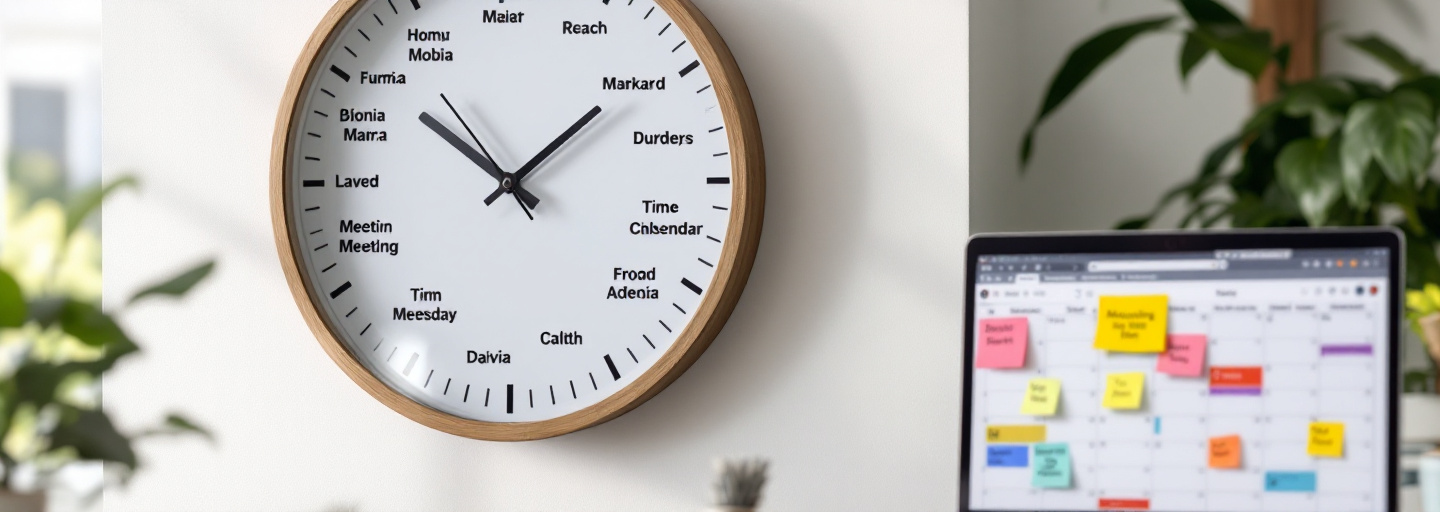5 Ways to Stay on Track with Multiple Alarms Throughout the Day
« Back to all blog postsLearn five practical ways to use multiple alarms to stay focused, manage time zones, and build better daily routines with AlarmClockTab.
Research shows the average person checks their phone nearly 100 times daily, often just to see what time it is.
This constant time-checking not only interrupts focus but also creates a subtle anxiety about staying on schedule.
Strategic use of multiple alarms offers a surprisingly simple solution to this common problem.
Why Multiple Alarms Help You Stay Focused
When your brain constantly monitors the clock, it diverts valuable mental resources away from your actual work. Multiple alarms function as external time checkpoints that free up this mental bandwidth.
Think of alarms as delegation tools for your brain. Instead of keeping track of five upcoming tasks and their timing, you can fully immerse yourself in your current activity while your alarm clock productivity system handles the transitions.
This approach significantly reduces decision fatigue. Each time you wonder “Should I switch tasks now or keep going?” you’re making a small decision that adds to your daily mental load. Predetermined alarms eliminate these micro-decisions.
The psychology behind effective alarm use is compelling. External time cues create a sense of gentle urgency that combats procrastination. When you know a timer is counting down, you’re more likely to maintain focus rather than drift to distractions.
Studies in behavioral psychology confirm that external accountability mechanisms improve task completion rates. Your alarm becomes an accountability partner that signals when to start working, when to take breaks, and when to transition between activities.
Digital tools like AlarmClockTab make this process seamless, allowing you to set up a comprehensive system of reminders without constantly checking the time yourself.
Set Alarms for Specific Task Blocks

Time blocking transforms how you approach your day by assigning specific activities to predetermined time slots. Adding alarms to signal these transitions creates a rhythm that guides your focus throughout the day.
The most effective time blocks typically range from 30-90 minutes, aligning with natural attention cycles. Shorter blocks work well for administrative tasks, while longer periods support deep, focused work that requires uninterrupted concentration.
Match your alarm tones to different activities to create mental associations. Use gentle sounds for transitions between tasks, distinctive tones for important meetings, and energetic sounds to signal the start of focused work sessions.
A daily alarm schedule might include:
| Time Block | Duration | Recommended Alarm Type | Purpose |
|---|---|---|---|
| Deep Work | 60-90 minutes | Gentle start/end tones | Focused project work |
| Meetings | 5 min before start | Distinctive alert | Preparation reminder |
| Breaks | 15-20 minutes | Relaxing sound | Mental reset |
| Admin Tasks | 30 minutes | Standard tone | Emails, planning, etc. |
| Transition | 5-10 minutes | Soft reminder | Shift between tasks |
This table outlines effective time block structures based on productivity research and cognitive attention spans. Customize these durations based on your personal energy patterns and work requirements.
Unlike simple reminders, alarms for task blocks create firm boundaries between activities. This structure prevents the common problem of tasks bleeding into each other and helps maintain focus on one activity at a time.
Setting up preset alarms saves significant time when creating your structured daily schedule, allowing you to activate your entire productivity system with just a few clicks.
Use Alarms to Reinforce Healthy Habits
Habit formation research shows that consistent cues are essential for establishing automatic behaviors. Alarms provide these reliable triggers, transforming occasional healthy choices into consistent routines.
Strategic alarm placement throughout your day can support physical wellbeing in several key areas:
- Set hydration alarms every 2 hours to maintain consistent water intake
- Create movement reminders to stand up and stretch after periods of sitting
- Use gentle evening alarms to signal the start of your wind-down routine
- Set morning alarms that allow time for healthy start-up habits before work begins
- Create meal-time alarms to maintain consistent eating patterns
The concept of habit stacking works particularly well with alarms. When your hydration reminder sounds, use that moment to also check your posture, look away from your screen, or take three deep breaths.
Morning and evening routines benefit tremendously from alarm anchoring. A consistent wake-up time helps regulate your circadian rhythm, while evening alarms can signal when to begin winding down technology use for better sleep quality.
For exercise consistency, alarms remove the decision-making that often leads to skipped workouts. A scheduled alert at your designated exercise time creates an external commitment that’s harder to ignore than a vague intention.
Workout timing becomes even more effective with specialized tools like circuit training timers that automatically manage intervals, allowing you to focus entirely on your exercise form rather than watching the clock.
Remember that habit-building takes time. Your brain needs about 66 days on average to form automatic behaviors, so maintain your alarm system even when motivation fluctuates.
Plan Around Time Zones for Global Coordination

Remote work and global teams have made time zone navigation an essential skill. Strategic alarms eliminate the confusion and missed connections that plague international coordination.
The most common time zone mistakes happen when calculating meeting times mentally. A time zone alarm planner removes this error-prone process by automatically accounting for differences between locations.
Always set two alarms for international meetings: a preparation reminder 15-30 minutes before and a start-time alert. Label these alarms with participant names and their local times to maintain awareness of others’ work hours.
| Time Zone Challenge | Alarm Strategy | Implementation Tip |
|---|---|---|
| Early morning calls with Asia | Set two alarms: 30 min before and at meeting time | Label alarms with participant names and their local time |
| Late evening meetings with Europe | Set reminder alarms throughout day | Include preparation reminders 2-3 hours before |
| Coordinating across 3+ time zones | Create a dedicated alarm set for each project | Use location names in alarm labels |
| Daylight saving time changes | Set calendar alerts for time changes | Verify times 24 hours before important meetings |
This table is based on common challenges reported by remote teams working across multiple time zones. The strategies focus on reducing confusion and ensuring proper preparation for global meetings.
When scheduling recurring international meetings, verify the current local time in each location rather than relying on memory. Tools that show the current time in Lagos or the current time in Phuket eliminate guesswork when coordinating across continents.
For teams spanning multiple time zones, create “overlap alarms” that remind you when colleagues in different regions are available for synchronous communication. This maximizes productive collaboration windows.
Remember that time zone coordination isn’t just about meetings. Set alarms for appropriate times to send emails, share documents, or request feedback based on recipients’ working hours.
Customize Alarm Settings for Better Focus
Generic alarms often become background noise that our brains learn to ignore. Thoughtful customization prevents this alarm fatigue and maintains their effectiveness.
The words you use in alarm labels significantly impact your response. Replace vague descriptions (“Meeting prep”) with specific action instructions (“Review presentation notes and test video connection”).
Your environment should determine your alarm type. Consider these options for different situations:
- Label alarms with specific actions (“Review presentation notes” rather than “Meeting prep”)
- Choose distinct sounds for different types of activities to create mental associations
- Use vibration-only alarms for subtle reminders in professional settings
- Set graduated alarms that increase in volume or intensity for critical deadlines
- Review and adjust your alarm system weekly to prevent habituation
Specialized timing techniques like the Pomodoro method become more effective with custom alarms. Using Pomodoro timers creates a rhythm of focused work and intentional breaks that maintains productivity while preventing burnout.
For high-stakes deadlines or early morning wake-ups, consider using multiple alarms with increasing urgency. Start with a gentle reminder that becomes progressively more noticeable if not acknowledged.
Weekly alarm audits prevent system breakdown. Ask yourself: “Which alarms did I ignore this week?” and “Which transitions felt rushed or stressful?” Then adjust your settings accordingly.
Quick Tips to Avoid Alarm Fatigue
Our brains naturally tune out repetitive stimuli through a process called habituation. This explains why even the most carefully planned alarm system can lose effectiveness over time.
Quality matters more than quantity when it comes to how to use alarms effectively. Focus on these strategies to maintain their impact:
- Limit yourself to 5-7 critical alarms daily to prevent alarm fatigue
- Change alarm sounds weekly to keep them noticeable to your brain
- Combine audio alarms with visual reminders for important deadlines
- Create a clear hierarchy – use distinctive sounds only for truly urgent matters
- Take an “alarm holiday” occasionally to reset your sensitivity to alerts
Not every reminder needs to be an alarm. For lower-priority tasks, consider alternative systems like task list notifications, sticky notes, or visual cues in your workspace.
The most common sign of alarm fatigue is the “dismiss and forget” pattern. If you find yourself turning off alarms without taking the intended action, it’s time to refresh your system.
Using preset timers can help streamline your setup and prevent alarm overload by creating standardized timing patterns that require minimal adjustment.
Remember that alarms work best as servants, not masters. They should create a supportive structure that enhances your natural productivity rather than imposing rigid control that feels restrictive.
With thoughtful implementation, multiple alarms throughout your day can transform from annoying interruptions into valuable allies that guide your focus, protect your time, and help you accomplish what matters most.
